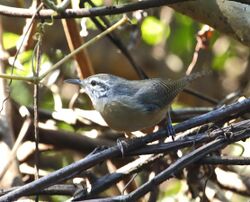Biology:Fawn-breasted wren
| Fawn-breasted wren | |
|---|---|

| |
| Scientific classification | |
| Domain: | Eukaryota |
| Kingdom: | Animalia |
| Phylum: | Chordata |
| Class: | Aves |
| Order: | Passeriformes |
| Family: | Troglodytidae |
| Genus: | Cantorchilus |
| Species: | C. guarayanus
|
| Binomial name | |
| Cantorchilus guarayanus (Lafresnaye & D'Orbigny, 1837)
| |

| |
| Synonyms | |
|
Thryothorus guarayanus | |
The fawn-breasted wren (Cantorchilus guarayanus) is a species of bird in the family Troglodytidae. It is found in Bolivia, Brazil , and Paraguay.[1]
Taxonomy and systematics
The fawn-breasted wren has sometimes been treated as conspecific with the buff-breasted wren (Cantorchilus leucotis), though they have very different vocalizations.[2] The species is monotypic.[1]
Description
The fawn-breasted wren is 13.5 cm (5.3 in) long and weighs 13 to 14 g (0.46 to 0.49 oz). Adults have a plain medium brown crown and upperparts that becomes rufescent on the lower back and rump. Their tail is reddish brown with crisp black bars. They have a narrow white supercilium mostly behind the eye, cheeks mottled gray-white and blackish, and black malar and moustacial stripes. Their chin is whitish, the chest a warm orange-buff, and the belly and vent area a deeper orange-buff. Juveniles are similar but their facial markings are less distinct.[2]
Distribution and habitat
The fawn-breasted wren is found across much of northeastern Bolivia, a fairly thin slice of adjacent western Brazil, and a small part of northeastern Paraguay. It inhabits várzea scrubland and secondary forest, mostly near water. In elevation it ranges up to approximately 400 m (1,300 ft).[2]
Behavior
Feeding
The fawn-breasted wren forages in pairs during the dry season and small family groups after nesting. It hunts in dense growth, usually from the ground up to 4 m (13 ft) above it, but sometimes as high as 10 m (33 ft). Its diet has not been documented.[2]
Breeding
Only a few fawn-breasted wren nests have been described, and little has been published about its breeding phenology. Nests are a flimsy dome of grasses and root hairs with a side entrance placed up to 3 m (9.8 ft) above ground in weeds, bushes, or the base of a small palm. The clutch size is two.[2]
Vocalization
The members of a fawn-breasted wren pair sing antiphonally, the male's part a "cheerilo-choli" and the female's "pew-pew, pew-pew". Calls include a repeated "pew-pew" and harsh clicks.[2]
Status
The IUCN has assessed the fawn-breasted wren as being of Least Concern. Though its population size has not been determined, it is believed to be fairly common to common across its range.[3][2]
References
- ↑ 1.0 1.1 Gill, F.; Donsker, D.; Rasmussen, P. (January 2021). "IOC World Bird List (v 11.1)". https://www.worldbirdnames.org/.
- ↑ 2.0 2.1 2.2 2.3 2.4 2.5 2.6 Kroodsma, D. E. and D. Brewer (2020). Fawn-breasted Wren (Cantorchilus guarayanus), version 1.0. In Birds of the World (J. del Hoyo, A. Elliott, J. Sargatal, D. A. Christie, and E. de Juana, Editors). Cornell Lab of Ornithology, Ithaca, NY, USA. https://doi.org/10.2173/bow.fabwre1.01 retrieved June 7, 2021
- ↑ Cite error: Invalid
<ref>tag; no text was provided for refs namedIUCN
External links
- Fawn-breasted Wren on the Internet Bird Collection
- Article w/Graphic of wren oiseaux.net
Wikidata ☰ Q625848 entry
 |


